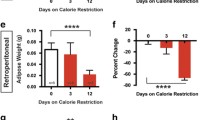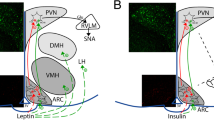Abstract
The relationship between obesity and sympathetic nervous system (SNS) behavior has been controversial. Existing paradigms have been opposed in their views of the directional changes in SNS activity in obesity. In addition, limitations of previous approaches to assess SNS activity have produced inconsistent findings. However, the use of state-of-the-art neurochemical and neurophysiologic techniques has improved our current understanding of this issue. There is regional heterogeneity in the SNS activation associated with obesity, with the renal and skeletal muscle circulations, but not the heart, being targets for SNS activation. Abdominal visceral fat appears to be an important depot linking obesity and skeletal muscle SNS activation. The impact of this depot on SNS activity to the kidney or other regions is unknown. Future studies are needed to address this issue as well as the mechanisms and consequences of SNS activation in visceral obesity.
Similar content being viewed by others
References and Recommended Reading
Flegal KM, Carroll MD, Ogden CL, Johnson CL: Prevalence and trends in obesity among US adults, 1999–2000. JAMA 2002, 288:1723–1727.
Ford ES, Mokdad AH, Giles WH:. Trends in waist circumference among U.S. adults. Obes Res 2003, 11:1223–1231.
Eckel R: Obesity and heart disease: a statement for healthcare professionals from the Nutrition Committee, American Heart Association. Circulation 1997, 96:3248–3250.
Despres JP, Lemieux I, Prud’homme D: Treatment of obesity: need to focus on high risk abdominally obese patients. BMJ 2001, 322:716–720.
Pi-Sunyer FX: The obesity epidemic: pathophysiology and consequences of obesity. Obes Res 2002, 10(Suppl 2):97S-104S.
Wilson P, Kannel W, Silbershatz H, D’Agostino R: Clustering of metabolic risk factors and coronary heart disease. Arch Intern Med 1999, 159:1104–1109.
Ravussin E, Tataranni PA: The role of altered sympathetic nervous system activity in the pathogenesis of obesity. Proc Nutr Soc 1996, 55:793–802. An interesting review of the potential role of the sympathetic nervous system in the pathogenesis of obesity.
Grassi G, Seravalle G, Dell’Oro R, et al.: Adrenergic and reflex abnormalities in obesity-related hypertension. Hypertension 2000, 36:538–542. An original investigation describing the alterations in skeletal muscle SNS activity and arterial baroreflex function in nonobese and obese hypertensive compared with normotensive humans.
Grassi G, Seravalle G, Quarti-Trevano F, et al.: Effects of hypertension and obesity on the sympathetic activation of heart failure patients. Hypertension 2003, 42:873–877.
Bray GA: Obesity, a disorder of nutrient partitioning: the MONA LISA hypothesis. J Nutr 1991, 121:1146–1162. This review proposes the hypothesis that obesity is associated with low sympathetic nervous system activity.
Landsberg L: Diet, obesity and hypertension: an hypothesis involving insulin, the sympathetic nervous system, and adaptive thermogenesis. Q J Med 1986, 61:1081–1090. This review proposes that sympathetic nervous system activation is the result of the insulin resistance that develops with obesity. In turn, sympathetic nervous system-mediated thermogenesis increases in attempts to prevent further weight gain. Landsberg proposes that hypertension develops as an unfortunate consequence of sympathetic nervous system activation.
Young J, Macdonald I: Sympathoadrenal activity in human obesity: heterogeneity of findings since 1980. Int J Obesity 1992, 16:959–967. An important review of the earlier contentious studies focused on understanding the obesity and sympathetic nervous system activity.
Coppack SW, Horowitz JF, Paramore DS, et al.: Whole body, adipose tissue, and forearm norepinephrine kinetics in lean and obese women. Am J Physiol 1998, 275:E830-E834.
Rumantir MS, Vaz M, Jennings GL, et al.: Neural mechanisms in human obesity-related hypertension. J Hypertens 1999, 17:1125–1133.
Vaz M, Jennings G, Turner A, et al.: Regional sympathetic nervous activity and oxygen consumption in obese normotensive human subjects. Circulation 1997, 96:3423–3429. This paper describes the results of whole-body and region norepinephrine kinetic studies in obese and nonobese humans. Renal norepinephrine was higher, cardiac norepinephrine spillover rate was lower, and hepatomesenteric spillover was similar in obese compared with nonobese humans.
Alvarez GE, Beske SD, Ballard TP, Davy KP: Sympathetic neural activation in visceral obesity. Circulation 2002, 106:2533–2536. This paper describes the results of an original investigation that suggests that skeletal muscle sympathetic nervous system activity is elevated in men with visceral obesity. The observations are consistent with the idea that abdominal visceral fat is an important adipose tissue depot linking obesity with sympathetic neural activation in humans.
Gudbjornsdottir S, Lonnroth P, Sverrisdottir Y, et al.: Sympathetic nerve activity and insulin in obese normotensive and hypertensive men. Hypertension 1996, 27:276–280.
Scherrer U, Randin D, Tappy L, et al.: Body fat and sympathetic nerve activity in healthy subjects. Circulation 1994, 89:2634–2640.
Spraul M, Anderson EA, Bogardus C, Ravussin E: Muscle sympathetic nerve activity in response to glucose ingestion: impact of plasma insulin and body fat. Diabetes 1994, 43:191–196.
Spraul M, Ravussin E, Fontvieille AM, et al.: Reduced sympathetic nervous activity: a potential mechanism predisposing to body weight gain. J Clin Invest 1993, 92:1730–1735.
Weyer C, Pratley RE, Snitker S, et al.: Ethnic differences in insulinemia and sympathetic tone as links between obesity and blood pressure. Hypertension 2000, 36:531–537.
Jones PP, Davy KP, Alexander S, Seals DR: Age-related increase in muscle sympathetic nerve activity is associated with abdominal adiposity. Am J Physiol 1997, 272:E976-E980.
Jones PP, Davy KP, Seals DR: Relations of total and abdominal adiposity to muscle sympathetic nerve activity in healthy older males. Int J Obes Relat Metab Disord 1997, 21:1053–1057.
Schwartz RS, Jaeger LF, Veith RC, Lakshminarayan S: The effect of diet or exercise on plasma norepinephrine kinetics in moderately obese young men. Int J Obes Relat Metab Disord 1990, 14:1–11.
Grassi G, Seravalle G, Colombo M, et al.: Body weight reduction, sympathetic nerve traffic, and arterial baroreflex in obese normotensive humans. Circulation 1998, 97:2037–2042.
Trombetta IC, Batalha LT, Rondon MU, et al.: Weight loss improves neurovascular and muscle metaboreflex control in obesity. Am J Physiol 2003, 285:H974-H982.
Alvarez G, Ballard T, Beske S, Davy K: Subcutaneous obesity is not associated with sympathetic neural activation. Am J Physiol Heart Circ Physiol 2004 Feb 26 [Epub ahead of print].
Monroe MB, Van Pelt RE, Schiller BC, et al.: Relation of leptin and insulin to adiposity-associated elevations in sympathetic activity with age in humans. Int J Obes Relat Metab Disord 2000, 24:1183–1187.
Anderson E, Hoffman R, Balon T, et al.: Hyperinsulinemia produces both sympathetic neural activation and vasodilation in normal humans. J Clin Invest 1991, 87:2246–2252.
Scherrer U, Owlya R, Trueb L: Sympathetic-nerve activity before and after resection of an insulinoma. N Engl J Med 1996, 335:1240–1242.
Ahima RS, Flier JS: Leptin. Annu Rev Physiol 2000, 62:413–437.
Hall JE: The kidney, hypertension, and obesity. Hypertension 2003, 41:625–633. excellent comprehensive review on the renal mechanisms responsible for the well-documented relation between obesity and hypertension.
Haynes WG: Interaction between leptin and sympathetic nervous system in hypertension. Curr Hypertens Rep 2000, 2:311–318. A thoughtful review of the acute and chronic cardiovascular actions of leptin.
Russell CD, Petersen RN, Rao SP, et al.: Leptin expression in adipose tissue from obese humans: depot-specific regulation by insulin and dexamethasone. Am J Physiol 1998, 275:E507-E515.
Lonnqvist F, Wennlund A, Arner P: Relationship between circulating leptin and peripheral fat distribution in obese subjects. Int J Obes Relat Metab Disord 1997, 21:255–260.
Snitker S, Pratley RE, Nicolson M, et al.: Relationship between muscle sympathetic nerve activity and plasma leptin concentration. Obes Res 1997, 5:338–340.
Narkiewicz K, Kato M, Phillips BG, et al.: Leptin interacts with heart rate but not sympathetic nerve traffic in healthy male subjects. J Hypertens 2001, 19:1089–1094.
Rosmond R, Chagnon YC, Holm G, et al.: Hypertension in obesity and the leptin receptor gene locus. J Clin Endocrinol Metab 2000, 85:3126–3131.
Reid IA: Interactions between ANG II, sympathetic nervous system, and baroreceptor reflexes in regulation of blood pressure. Am J Physiol 1992, 262:E763-E778.
Matsukawa T, Gotoh E, Minamisawa K, et al.: Effects of intravenous infusions of angiotensin II on muscle sympathetic nerve activity in humans. Am J Physiol 1991, 261:R690-R696.
Miyajima E, Shigemasa T, Yamada Y, et al.: Angiotensin II blunts, while angiotensin converting enzyme inhibitor augments, reflex sympathetic inhibition in humans. Clin Exper Pharmacol Physiol 1999, 26:797–802.
Engeli S, Negrel R, Sharma AM: Physiology and pathophysiology of the adipose tissue renin-angiotensin system. Hypertension 2000, 35:1270–1277.
Grassi G, Seravalle G, Dell’Oro R, et al.: Comparative effects of candesartan and hydrochlorothiazide on blood pressure, insulin sensitivity, and sympathetic drive in obese hypertensive individuals: results of the CROSS study. J Hypertens 2003, 21:1761–1769.
Bjorntorp P, Holm G, Rosmond R, Folkow B: Hypertension and the metabolic syndrome: Closely related central origin? Blood Press 2000, 9:71–82. This review proposes an interesting hypothesis involving a shared central mechanism responsible for hypertension and the metabolic syndrome.
Dodt C, Wallin G, Fehm HL, Elam M: The stress hormone adrenocorticotropin enhances sympathetic outflow to the muscle vascular bed in humans. J Hypertens 1998, 16:195–201.
Grassi G, Seravalle G, Dell’Oro R, et al.: Participation of the hypothalamus-hypophysis axis in the sympathetic activation of human obesity. Hypertension 2001, 38:1316–1320.
Arrone L, Mackintosh R, Rosenbaum M, et al.: Autonomic nervous system activity in weight gain and weight loss. Am J Physiol 1995, 269:R222-R225.
Agapitov A, Correria M, Dopp J, et al.: Weight loss does not alter sympathetically mediated vascular tone in normotensive obese humans. J Am Coll Cardiol 2002, 39:268.
Jern S: Hemodynamics of the male fat distribution pattern. Blood Press 1992, 1:21–29.
Esler M, Rumantir M, Wiesner G, et al.: Sympathetic nervous system and insulin resistance: from obesity to diabetes. Am J Hypertens 2001, 14:304S-309S.
Author information
Authors and Affiliations
Rights and permissions
About this article
Cite this article
Davy, K.P. The global epidemic of obesity: Are we becoming more sympathetic?. Current Science Inc 6, 241–246 (2004). https://doi.org/10.1007/s11906-004-0076-7
Issue Date:
DOI: https://doi.org/10.1007/s11906-004-0076-7




